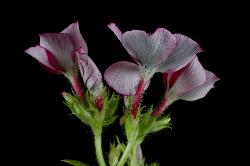- Taxon
- Gallery
Annual herb to c. 50 cm high, glandular-hairy, with a single, branching taproot; stems ± villous, branched or remaining simple. Lvs sessile; lower and middle lvs opposite, 0.5–4.5 × 0.2–1.2 cm, narrow-elliptic to ovate; margins densely ciliate; base attenuate, sometimes amplexicaul; apex acute; upper lvs just below infl. smaller, nearly always alternate. Cymes many- to few-flowered; fls not fragrant, sometimes solitary on small plants. Bracts lanceolate or linear-lanceolate, ciliate, mostly much > pedicels or calyx. Pedicels very short except in uppermost fl., densely glandular-hairy. Calyx c. 8 mm long, densely glandular-hairy; tube > lobes and with broad transparent membrane between lobes (below sinus); lobes subulate to subulate-lanceolate, reflexed at fruiting. Corolla tube 1–1.5 cm long, narrow-cylindric, glandular-hairy outside; limb 2–2.5 cm diam., white, pink to rose, blue or purple; lobes broad, rounded or obtuse. Anthers > filaments, c. 1 mm long. Style very short, filiform, < stigmas. Capsule 3–3.5 mm long. Seed 2.5–3 mm long, ± ellipsoid, flattened and with longitudinal groove on one side, indistinctly pitted.
[From: Webb et al. (1988) Flora of New Zealand. Volume 4.]
Flowering: Nov.–Mar.




